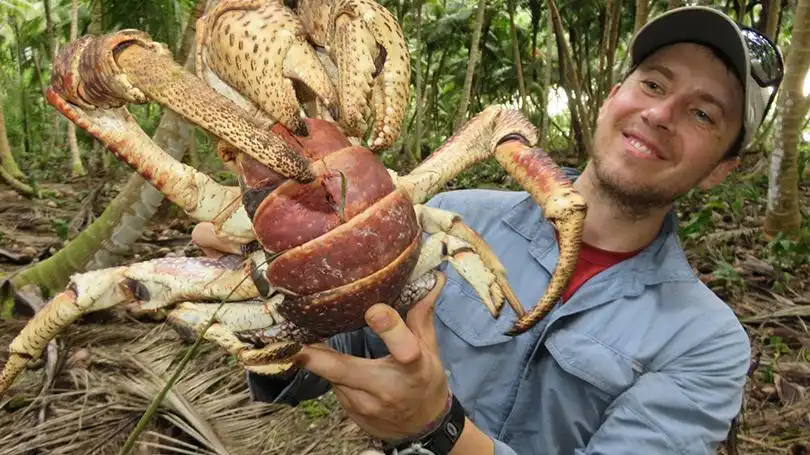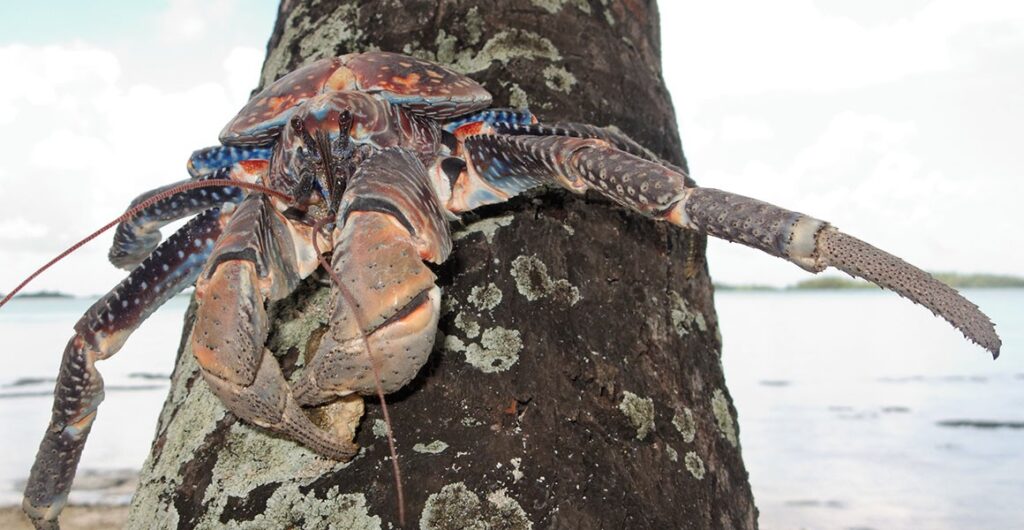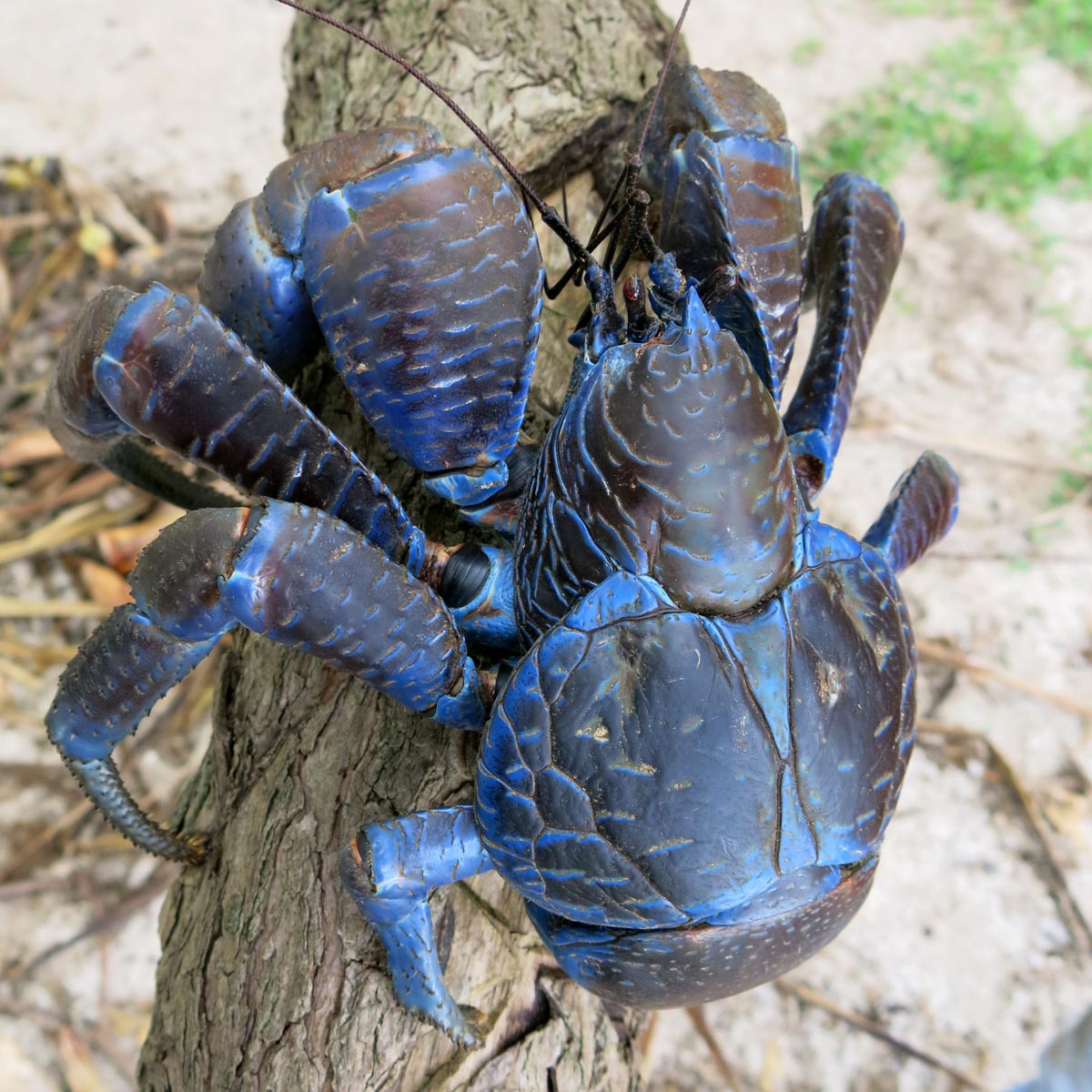The World’s Largest Land Crab Is Fierce—Coconut Crab Under Threat

It could be a scene from a science fiction movie: giant, omnivorous crabs—the size of small dogs—feasting on coconuts, which they crush with their claws, and climbing trees in search of live prey. But the enormous crabs are themselves vulnerable—to human predators. “They grow to monstrous size,” Charles Darwin noted when he encountered them in his travels in the 1830s, and “are very good to eat.”
As their numbers dwindle, these “invertebrate dinosaurs” need to be better understood, says Mark Laidre, an assistant professor of biological sciences. With a research grant from the National Geographic Society, he has been studying the crabs’ biology, behavior, and ecology in one of their few remaining strongholds, the Chagos Archipelago in the Indian Ocean.
“These crabs may weigh up to nine pounds, have a leg span of more than a meter across, and live more than 60 years,” says Laidre. Strong and well armored, they are also skilled hunters. Laidre has a paper, which will be published later this year, describing gory details of coconut crabs preying on other animals.
But despite their intimidating size, coconut crabs are in trouble, he says. “People are eating them or destroying their habitat. With sea levels rising, in another 10 to 20 years many of the coral atolls on which they live are going to get drowned.”
The crabs’ longevity is another factor working against their survival as a species. “It’s not hard to totally decimate populations, since it might take 50 to 100 years to fill the void left by the harvested adults,” Laidre says.
Although the coconut crab has not been declared a threatened species, the International Union for Conservation of Nature has classified the species as “data deficient.” This means that “even though the species has become locally extinct on many islands, no one has compiled information over their range throughout the Indo-Pacific,” Laidre says. With a network of collaborators, he is trying to change this, launching an effort to conduct systematic census taking and collecting data on populations’ genetic diversity.
Laidre is spreading his message of protection and preservation, in part by sharing his enthusiasm with schoolchildren and sponsoring an art exhibit, free and open to the public, at Dartmouth’s Class of 1978 Life Sciences Center. “The exhibit includes preserved specimens of the humongous crabs as well as artwork inspired by these extraordinary creatures,” says Laidre. Woodcarvings, paintings, watercolors, glass sculptures, and even sections from a science fiction trilogy (all inspired by coconut crabs) are on display on the third floor of the Life Sciences building.
Mark Laidre has assembled a collection of coconut crab art that’s on display at the Class of 1978 Life Sciences Center. In his hand is a glass sculpture that artist Robert DuGrenier made from an impression of a crab in sand (see detail below). (Photo by Robert Gill)Recently he visited the Frances C. Richmond Middle School in Hanover, N.H., where he spoke with students and gave them an up-close look at a preserved coconut crab. “They seemed to really get a kick out of the crabs,” Laidre says. “That’s my new favorite animal,” said one middle-schooler. “Oh, that’s gross and scary,” exclaimed another. “But overall, they loved them and some had quite insightful questions about behavior and scientific experiments,” Laidre says.
This term, he is in Costa Rica, teaching a Dartmouth tropical ecology field course that focuses on animal behavior and ecology. Laidre has conducted research in Costa Rica focusing on the social life of terrestrial hermit crabs, close evolutionary relatives of coconut crabs.
In the spring, he and fellow biologist Thomas Jack will co-teach a new course they developed, “Animal Minds,” which will explore how animals, from invertebrates to primates, make decisions.
The decision Laidre thinks most important is one humanity as a whole will have to make about conserving coconut crabs: “Only if we work together will we stand a chance of protecting these amazing animals for generations to come.” source
The mighty pinch of the coconut crab
The coconut crab, or “robber crab” (Birgus latro), is the largest terrestrial arthropod in the world, with individuals weighing up to four kg (about 9 pounds). They have a wide range:
But because of their size and the fact that they’re tasty, they’ve been largely driven extinct by humans on populated islands. Here’s how big they are:
They come in different colors, often red or blue. Here’s a beautiful blue one:
Two facts about these species. First, they’re fairly close relatives of the hermit crab, and in fact are descended from hermit crabs that occupied shells throughout their lives. But this species is sufficiently large as to have few predators besides humans, and so only the very young and small coconut crabs live in shells (sometimes bits of coconut shells). They’re also completely terrestrial, and will die if put in salt water.
You can see the hermit-crab ancestry in the reduced and curled abdomen behind the carapace:
Hermit crab without shell:
Coconut crab:
I’ve written two earlier posts on coconut crabs (here and here), including photos by reader Dennis Hansen from the Indian Ocean of Aldabra. There they invade the field station, making off with leftover food from the table, and they can also open garbage cans, as they have great climbing skills:
They’re HUGE! Second Fun Coconut Crab fact: they do indeed open coconuts, and can climb trees to get them, though they’re omnivores and coconuts are not a main part of their diet. Wikipedia gives the details (my emphasis):
The diet of coconut crabs consists primarily of fleshy fruits (particularly Ochrosia ackeringae, Arenga listeri, Pandanus elatus, P. christmatensis), nuts (coconuts Cocos nucifera, Aleurites moluccanus) and seeds (Annona reticulata), and the pith of fallen trees. However, as they are omnivores, they will consume other organic materials such as tortoise hatchlings and dead animals. They have been observed to prey upon crabs like Gecarcoidea natalis and Discoplax hirtipes, as well as scavenge on the carcasses of other coconut crabs. During a tagging experiment, one coconut crab was observed killing and eating a Polynesian Rat (Rattus exulans). Coconut crabs may be responsible for the disappearance of Amelia Earhart’s remains, consuming them after her death and hoarding her skeletal remnants in their burrows.
The coconut crab can take a coconut from the ground and cut it to a husk nut, take it with its claw, climb up a tree 10 m (33 ft) high and drop the husk nut, to access the coconut meat inside. They often descend from the trees by falling, and can survive a fall of at least 4.5 metres (15 ft) unhurt. Coconut crabs cut holes into coconuts with their strong claws and eat the contents, although it can take several days before the coconut is opened.
Thomas Hale Streets discussed the behaviour in 1877, doubting that the animal would climb trees to get at the nuts. In the 1980s, Holger Rumpff was able to confirm Streets’s report, observing and studying how they open coconuts in the wild. The animal has developed a special technique to do so: if the coconut is still covered with husk, it will use its claws to rip off strips, always starting from the side with the three germination pores, the group of three small circles found on the outside of the coconut. Once the pores are visible, the coconut crab will bang its pincers on one of them until they break. Afterwards, it will turn around and use the smaller pincers on its other legs to pull out the white flesh of the coconut. Using their strong claws, larger individuals can even break the hard coconut into smaller pieces for easier consumption.
Clearly, these animals must be strong. Indeed, they can lift up to 28 kg (62 pounds)—at least seven times their own weight.
This is all leading up to a new paper published in PLOS ONE by Shin-Ichiro Oka et al. (reference and free download below), in which the authors measured the pinching force of 29 coconut crabs. As you might expect, they pinch hard, exerting more force per gram of body weight than nearly any other animal, including terrestrial carnivores. source

Coconut crabs are the world’s largest land-dwelling crab © pattfwi via Flickr (CC BY-SA 2.0)
Coconut crabs: the bird-eating behemoths thriving on isolated tropical islands
You may be familiar with hermit crabs, the adorable and often tiny crustaceans that totter along the beach toting their bodies in seashells.
Meet their enormous relatives, coconut crabs. Their leg span is up to a metre, they have incredible grip strength and they can lift objects the weight of a 10-year-old child.
Coconut crabs (Birgus latro) might seem unusual: they’re absurdly large, land-dwelling, bird-hunting crustaceans. But on their isolated island homes, their peculiar traits work incredibly well for them.
What is a coconut crab?
To say that coconut crabs are big would be an understatement.
‘They’re a mega-crab, really,’ explains Miranda Lowe, Principal Curator of Crustacea at the Museum. ‘They range, but they can be huge – up to a metre leg span.’
They’re not quite the world’s largest crab – that would be the Japanese spider crab (Macrocheira kaempferi), which can reach a whopping 3.7 metres from claw to claw.
But the coconut crab is the largest crustacean that spends all its adult life on land, with a Guinness World Record to prove it. It’s also the biggest land-dwelling arthropod, the group of invertebrates that also includes insects, spiders and centipedes.
Coconut crabs can live up to 60 years, reaching sexual maturity at about five years old. They mate between May and September and females release their eggs into the water.
When they hatch, the larvae disperse on floating coconuts, logs or other rafts for four to six weeks. They then transform into shrimplike creatures called glaucothoe and sink to the seabed to find a suitable gastropod shell for protection. They will then begin to migrate towards the shore, spending another four weeks around the high-tide mark before they become juvenile crabs.

Coconut crabs only protect their bodies with shells whilst they are juveniles © Drew Avery via Flickr (CC BY 2.0)
As adults they no longer use gastropod shells and instead rely on their tough exoskeleton to protect them from predators.
Although they spend their multiple larval stages in water, when coconut crabs eventually become adults, they can’t swim. In fact, they drown if they end up underwater for a prolonged period. This is because instead of gills, they have branchiostegal lungs that allow them to breathe air.
Coconut crabs are found across the Indo-Pacific, from islands off the coast of Africa near Zanzibar to the Gambier Islands in the Eastern Pacific Ocean. They are typically found in coastal forests with plenty of rock crevices and soil for digging burrows. On some islands, they can be found up to six kilometres from the shore.
What do coconut crabs eat?
Their name might give it away, but coconut crabs are known for cracking into green coconuts to feast on the white flesh inside.
‘Their walking legs are kind of curved and clawlike, and they have an inward grip so they can climb palm trees and other trees,’ explains Miranda.

Curved legs and an inward grip make coconut crabs excellent climbers © KYTan via Shutterstock
Coconuts aren’t all they’ll munch on, however. Coconut crabs will eat fallen fruit, nuts and seeds.
Perhaps unexpectedly for crabs, they are also rather ruthless predators.
‘Most other crabs live exclusively on the water’s edge or in the ocean, and their food source is dead animals – marine worms, the flesh of other dead crabs, that sort of thing. They’re not exactly vicious hunters.’
Coconut crabs, however, are known predators of rats, others of their own species and even large migratory seabirds, such as boobies that they find nesting on their islands. They have been spotted mounting attacks in the dark of the night and grabbing unsuspecting prey that pass too close to the crabs’ burrows.
Miranda says, ‘It’s an adaptation because of their food source. On land, some of the time they have to find something else other than coconuts.’
Coconut crabs’ broad diets have even led some to suggest that the reason famed aviator Amelia Earhart was never found when she disappeared mid-flight over the Pacific Ocean was because she was devoured by coconut crabs after perishing on Nikumaroro island.

Coconut crabs have a varied diet including fruits, seeds and animals such as rats and seabirds © fearlessRich via Wikimedia Commons (CC BY 2.0)
How strong is a coconut crab?
If you have ever tried to open a coconut, you’ll know it can be a bit of a challenge. Not so for a coconut crab.
Armed with two large and powerful pincers, coconut crabs can pound and rip their way through the tough exterior of a coconut with relative ease.
Miranda says, ‘People may be familiar with crab pincers if they try and pick the animals up from the front and not the back. Coconut crabs’ pincers have a serrated edge, which are commonly known as teeth because they do act as teeth on the front claws. They’re used to crack open the coconuts.’
The squeeze of a coconut crab’s pincers can be much stronger than a human’s grip. Scientists tested the force exerted by 29 wild coconut crabs, unintentionally getting themselves pinched several times in the process, and found a maximum force of a little over 1,765 newtons. For reference, humans have a maximum bite force of between 1,100 and 1,300 newtons, based on a study using virtual models of human skulls.

There is a link between mass and pincer force in coconut crabs. The bigger the crab, the stronger their pincers are. © John Tann via Flickr (CC BY 2.0)
The bigger the mass of the crab, the greater the pincer force. When scaled up for a fully grown, four-kilogram coconut crab, the maximum force would be around 3,300 newtons.
Coconut crabs can also lift up to about 30 kilograms, approximately the weight of a 10-year-old child. Their powerful claws and strength are essential for accessing their various food sources.
Coconut crabs and humans
There haven’t been many large-scale studies on the populations of coconut crabs. We don’t accurately know how many there are, but the International Union for Conservation of Nature lists them as a Vulnerable species.
Coconut crabs don’t have many predators, thanks to their often isolated island homes. However, one of the biggest threats they face is from humans.
Miranda explains, ‘They’re such a large crab, so obviously they’ve got lots of crab meat in them. It’s really difficult to tell islanders that you should protect the species when it’s their food source.
‘Communities rely on them for food, but also to sell. It can have a major impact on the species.’

Coconut crabs are at risk from being overharvested by humans as well as facing threats from climate change © Drew Avery via Flickr (CC BY 2.0)
Coconut crab populations have been depleted on inhabited islands from overharvesting, but also habitat loss. Their slow population growth rate will add up to be a problem for the species’ survival.
There are regulations to help protect coconut crabs across many of the Pacific islands they inhabit, though the specifics of these are determined by each country.
Minimum harvest sizes are used on many Pacific islands – in some locations, females carrying eggs on their underside are also specifically protected. Some governments have set quotas for the amount of crabs that can be caught, and permits may be required to export this species, although in other areas exporting coconut crabs is entirely prohibited.
Another threat to the species is the total loss of their island homes. Many populations of coconut crabs depend on low-lying island atolls. Sea level rise caused by climate change is a big threat to these types of habitats, with some at risk of being entirely lost to the ocean.
Come See a Coconut crab – at the San Francisco Zoo

Fascinating Facts
- Coconut crabs are a type of hermit crab and are the world’s largest terrestrial arthropod (up to 3 feet across!).
- Unlike most other hermit crabs, only juveniles use shells to protect their abdomens; older coconut crabs develop a hard skin.
- They cannot swim, and will drown if immersed in water for long.
- They have large muscular claws to help open coconuts.
- Coconut crabs are hunted extensively for food, which can be problematic due to their long lifespan and slow growth rate.
- They can live to be over 60 years old!
Habitat/Diet
Coconut crabs live in rock crevices and burrow along the coast. They are nocturnal and feed on coconuts, fruit, and leaves. If coconuts aren’t already available on the ground, the coconut crab can climb trees to cut them down.
Status in the Wild
Data Deficient – IUCN 1996
Range
Found throughout tropical Indo-Pacific oceanic islands and offshore islets.
Location in the Zoo
Invertebrates Zone of the Sculpture Learning Plaza







